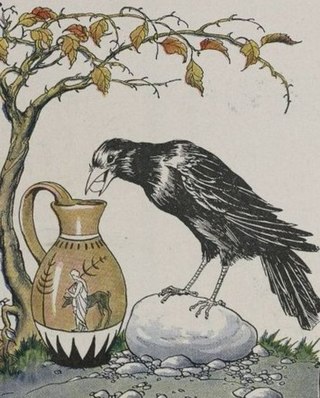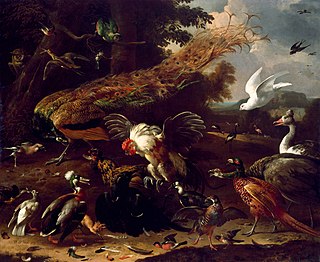
The Sick Kite is one of Aesop's Fables and is numbered 324 in the Perry Index. [1]

The Sick Kite is one of Aesop's Fables and is numbered 324 in the Perry Index. [1]
Greek versions of this fable are told of the raven (κοραξ) while it is called a kite (milvus) in Mediaeval Latin sources. The bird is ill and asks its grieving mother to pray in the temples on its behalf. The mother replies that since it was a robber of the sacrifices there, religious observance would now be of no use. The fable appears in the collection of William Caxton and in many others, generally with a reflection on the uselessness of death-bed repentance.
In the 1546 edition of the Emblemata by Andrea Alciato the story is modified. There the bird vomits and is told by its parent that it is losing nothing of its own, since all it has eaten was stolen. [2] The fable is used to illustrate the Latin proverb male parta, male dilabuntur (ill-gotten, ill-spent). A sceptical variation on the theme directed against religious observance later appeared in Gotthold Ephraim Lessing's collection of prose fables (1759). 'The fox, observing that the raven plundered the altars of the gods, and that he supported himself from their sacrifices, said to himself: I should like to know whether the raven partakes of their sacrifices because he is a prophetical bird; or whether he is deemed a prophetical bird because he is so insolent as to partake of the sacrifices?' [3]

The Wasp Factory is the first novel by Scottish writer Iain Banks, published in 1984. Before the book came out, Banks had written several science fiction novels that had not been accepted for publication. He decided to try a more mainstream novel in the hopes that it would be more readily accepted, and wrote about a psychopathic teenager living on a remote Scottish island. According to Banks, this allowed him to treat the story as something resembling science fiction – the island could be envisaged as a planet, and Frank, the protagonist, almost as an alien. Following the success of The Wasp Factory, Banks began to write full-time.

"The Raven" is a narrative poem by American writer Edgar Allan Poe. First published in January 1845, the poem is often noted for its musicality, stylized language and supernatural atmosphere. It tells of a distraught lover who is paid a visit by a mysterious raven that repeatedly speaks a single word. The lover, often identified as a student, is lamenting the loss of his love, Lenore. Sitting on a bust of Pallas, the raven seems to further antagonize the protagonist with its repetition of the word "Nevermore". The poem makes use of folk, mythological, religious, and classical references.

Aesop's Fables, or the Aesopica, is a collection of fables credited to Aesop, a slave and storyteller who lived in ancient Greece between 620 and 564 BCE. Of varied and unclear origins, the stories associated with his name have descended to modern times through a number of sources and continue to be reinterpreted in different verbal registers and in popular as well as artistic media.

Animal worship is an umbrella term designating religious or ritual practices involving animals. This includes the worship of animal deities or animal sacrifice. An animal 'cult' is formed when a species is taken to represent a religious figure. Animal cults can be classified according to their formal features or by their symbolic content.
The Miser and his Gold is one of Aesop's Fables that deals directly with human weaknesses, in this case the wrong use of possessions. Since this is a story dealing only with humans, it allows the point to be made directly through the medium of speech rather than be surmised from the situation. It is numbered 225 in the Perry Index.
The Deuteronomic Code is the name given by academics to the law code set out in chapters 12 to 26 of the Book of Deuteronomy in the Hebrew Bible. The code outlines a special relationship between the Israelites and Yahweh and provides instructions covering "a variety of topics including religious ceremonies and ritual purity, civil and criminal law, and the conduct of war". They are similar to other collections of laws found in the Torah such as the Covenant Code at Exodus 20–23, except for the portion discussing the Ethical Decalogue, which is usually treated separately. This separate treatment stems not from any concern over authorship, but merely because the Ethical Decalogue is treated academically as a subject in its own right.

The Crow and the Pitcher is one of Aesop's Fables, numbered 390 in the Perry Index. It relates ancient observation of corvid behaviour that recent scientific studies have confirmed is goal-directed and indicative of causal knowledge rather than simply being due to instrumental conditioning.

The Dog and Its Reflection is one of Aesop's Fables and is numbered 133 in the Perry Index. The Greek language original was retold in Latin and in this way was spread across Europe, teaching the lesson to be contented with what one has and not to relinquish substance for shadow. There also exist Indian variants of the story. The morals at the end of the fable have provided both English and French with proverbs and the story has been applied to a variety of social situations.

Corvus is a widely distributed genus of passerine birds ranging from medium-sized to large-sized in the family Corvidae. It includes species commonly known as crows, ravens, and rooks. The species commonly encountered in Europe are the carrion crow, hooded crow, common raven, and rook; those discovered later were named "crow" or "raven" chiefly on the basis of their size, crows generally being smaller. The genus name is Latin for "raven".
Clerics regular or clerks regular are clerics who are members of a religious order under a rule of life (regular). Clerics regular differ from canons regular in that they devote themselves more to pastoral care, in place of an obligation to the praying of the Liturgy of the Hours in common, and have fewer observances in their rule of life.

The Farmer and the Stork is one of Aesop's Fables which appears in Greek in the collections of both Babrius and Aphthonius and has differed little in the telling over the centuries. The story relates how a farmer plants traps in his field to catch the cranes and geese that are stealing the seeds he has sown. When he checks the traps, he finds among the other birds a stork, who pleads to be spared because it is harmless and has taken no part in the theft. The farmer replies that since it has been caught in the company of thieves, it must suffer the same fate. The moral of the story, which is announced beforehand in the oldest texts, is that associating with bad companions will lead to bad consequences.

Many references to ravens exist in world lore and literature. Most depictions allude to the appearance and behavior of the wide-ranging common raven. Because of its black plumage, croaking call, and diet of carrion, the raven is often associated with loss and ill omen. Yet, its symbolism is complex. As a talking bird, the raven also represents prophecy and insight. Ravens in stories often act as psychopomps, connecting the material world with the world of spirits.

The Fox and the Crow is one of Aesop's Fables, numbered 124 in the Perry Index. There are early Latin and Greek versions and the fable may even have been portrayed on an ancient Greek vase. The story is used as a warning against listening to flattery.

The Tortoise and the Birds is a fable of probable folk origin, early versions of which are found in both India and Greece. There are also African variants. The moral lessons to be learned from these differ and depend on the context in which they are told.

The Earl and the Fairy is a completed series of light novels written by Mizue Tani and published in Japan by Shueisha. The story is serialized in Cobalt magazine and illustrated by Asako Takaboshi (Ayuko).
The Hawk and the Nightingale is one of the earliest fables recorded in Greek and there have been many variations on the story since Classical times. The original version is numbered 4 in the Perry Index and the later Aesop version, sometimes going under the title "The Hawk, the Nightingale and the Birdcatcher", is numbered 567. The stories began as a reflection on the arbitrary use of power and eventually shifted to being a lesson in the wise use of resources.

The Bird in Borrowed Feathers is a fable of Classical Greek origin usually ascribed to Aesop. It has existed in numerous different versions between that time and the Middle Ages, going by various titles and generally involving members of the corvid family. The lesson to be learned from it has also varied, depending on the context in which it was told. Several idioms derive from the fable.

The Amburbium was an ancient Roman festival for purifying the city; that is, a lustration (lustratio urbis). It took the form of a procession, perhaps along the old Servian Wall, though the length of 10 kilometers would seem impractical to circumambulate. If it was a distinct festival held annually, the most likely month is February, but no date is recorded and the ritual may have been performed as a "crisis rite" when needed.

The Frog and the Mouse is one of Aesop's Fables and exists in several versions. It is numbered 384 in the Perry Index. There are also Eastern versions of uncertain origin which are classified as Aarne-Thompson type 278, concerning unnatural relationships. The stories make the point that the treacherous are destroyed by their own actions.

The Eagle and the Fox is a fable of friendship betrayed and avenged. Counted as one of Aesop's Fables, it is numbered 1 in the Perry Index. The central situation concerns an eagle that seizes a fox's cubs and bears them off to feed its young. There are then alternative endings to the story, in one of which the fox exacts restitution, while in the other it gains retribution for its injury.